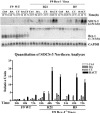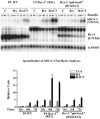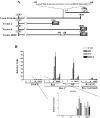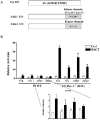Transcriptional activation of the suppressor of cytokine signaling-3 (SOCS-3) gene via STAT3 is increased in F9 REX1 (ZFP-42) knockout teratocarcinoma stem cells relative to wild-type cells
- PMID: 18237746
- PMCID: PMC2972193
- DOI: 10.1016/j.jmb.2007.12.038
Transcriptional activation of the suppressor of cytokine signaling-3 (SOCS-3) gene via STAT3 is increased in F9 REX1 (ZFP-42) knockout teratocarcinoma stem cells relative to wild-type cells
Abstract
Rex1 (Zfp42), first identified as a gene that is transcriptionally repressed by retinoic acid (RA), encodes a zinc finger transcription factor expressed at high levels in F9 teratocarcinoma stem cells, embryonic stem cells, and other stem cells. Loss of both alleles of Rex1 by homologous recombination alters the RA-induced differentiation of F9 cells, a model of pluripotent embryonic stem cells. We identified Suppressor of Cytokine Signaling-3 (SOCS-3) as a gene that exhibits greatly increased transcriptional activation in RA, cAMP, and theophylline (RACT)-treated F9 Rex1(-/-) cells (approximately 25-fold) as compared to wild-type (WT) cells ( approximately 2.5-fold). By promoter deletion, mutation, and transient transfection analyses, we have shown that this transcriptional increase is mediated by the STAT3 DNA-binding elements located between -99 to -60 in the SOCS-3 promoter. Overexpression of STAT3 dominant-negative mutants greatly diminishes this SOCS-3 transcriptional increase in F9 Rex1(-/-) cells. This increase in SOCS-3 transcription is associated with a four- to fivefold higher level of tyrosine-phosphorylated STAT3 in the RACT-treated F9 Rex1(-/-) cells as compared to WT. Dominant-negative Src tyrosine kinase, Jak2, and protein kinase A partially reduce the transcriptional activation of the SOCS 3 gene in RACT-treated F9 Rex1 null cells. In contrast, parathyroid hormone peptide enhances the effect of RA in F9 Rex1(-/-) cells, but not in F9 WT. Thus, Rex1, which is highly expressed in stem cells, inhibits signaling via the Janus kinase (JAK)/signal transducer and activator of transcription (STAT) pathway, thereby modulating the differentiation of F9 cells.
Figures












Similar articles
-
Retinoic acid receptor gamma activates receptor tyrosine kinase Tie1 gene transcription through transcription factor GATA4 in F9 stem cells.Exp Hematol. 2008 May;36(5):624-41. doi: 10.1016/j.exphem.2007.12.016. Exp Hematol. 2008. PMID: 18439490
-
Identification and characterization of retinoic acid receptor beta2 target genes in F9 teratocarcinoma cells.Mol Cancer Res. 2003 Jun;1(8):619-30. Mol Cancer Res. 2003. PMID: 12805409
-
Transcriptional regulation of Rex1 (zfp42) in normal prostate epithelial cells and prostate cancer cells.J Cell Physiol. 2010 Jul;224(1):17-27. doi: 10.1002/jcp.22071. J Cell Physiol. 2010. PMID: 20232320 Free PMC article.
-
Mouse cellular retinoic acid binding protein: cloning, complementary DNA sequence, and messenger RNA expression during the retinoic acid-induced differentiation of F9 wild type and RA-3-10 mutant teratocarcinoma cells.Cancer Res. 1989 Mar 15;49(6):1497-504. Cancer Res. 1989. PMID: 2538228
-
STAT3-Ser/Hes3 Signaling: A New Molecular Component of the Neuroendocrine System?Horm Metab Res. 2016 Feb;48(2):77-82. doi: 10.1055/s-0041-111699. Epub 2016 Jan 19. Horm Metab Res. 2016. PMID: 26783739 Review.
Cited by
-
Synthesis, Hemolytic Studies, and In Silico Modeling of Novel Acefylline-1,2,4-Triazole Hybrids as Potential Anti-cancer Agents against MCF-7 and A549.ACS Omega. 2021 Apr 30;6(18):11943-11953. doi: 10.1021/acsomega.1c00424. eCollection 2021 May 11. ACS Omega. 2021. PMID: 34056349 Free PMC article.
-
REX-1 expression and p38 MAPK activation status can determine proliferation/differentiation fates in human mesenchymal stem cells.PLoS One. 2010 May 5;5(5):e10493. doi: 10.1371/journal.pone.0010493. PLoS One. 2010. PMID: 20463961 Free PMC article.
-
Embryonic stem cell factors undifferentiated transcription factor-1 (UFT-1) and reduced expression protein-1 (REX-1) are widely expressed in human skin and may be involved in cutaneous differentiation but not in stem cell fate determination.Int J Exp Pathol. 2011 Oct;92(5):326-32. doi: 10.1111/j.1365-2613.2011.00769.x. Epub 2011 Mar 29. Int J Exp Pathol. 2011. PMID: 21446939 Free PMC article.
-
Production of offspring from a germline stem cell line derived from neonatal ovaries.Nat Cell Biol. 2009 May;11(5):631-6. doi: 10.1038/ncb1869. Epub 2009 Apr 12. Nat Cell Biol. 2009. PMID: 19363485
-
Rex1 (Zfp42) null mice show impaired testicular function, abnormal testis morphology, and aberrant gene expression.Dev Biol. 2011 Aug 15;356(2):370-82. doi: 10.1016/j.ydbio.2011.05.664. Epub 2011 May 27. Dev Biol. 2011. PMID: 21641340 Free PMC article.
References
-
- Gudas LJ. Molecular mechanisms of retinoid action. Am J Respir Cell Mol Biol. 1990;2:319–20. - PubMed
-
- Gudas LJ. Retinoids and vertebrate development. J Biol Chem. 1994;269:15399–402. - PubMed
-
- Means AL, Gudas LJ. The roles of retinoids in vertebrate development. Ann. Rev. Biochem. 1995;64:210–233. - PubMed
-
- Mongan NP, Gudas LJ. Diverse actions of retinoid receptors in cancer prevention and treatment. Differentiation. 2007 In press. - PubMed
-
- Mark M, Ghyselinck NB, Chambon P. Function of retinoid nuclear receptors: lessons from genetic and pharmacological dissections of the retinoic acid signaling pathway during mouse embryogenesis. Annu Rev Pharmacol Toxicol. 2006;46:451–80. - PubMed
Publication types
MeSH terms
Substances
Grants and funding
LinkOut - more resources
Full Text Sources
Molecular Biology Databases
Miscellaneous

